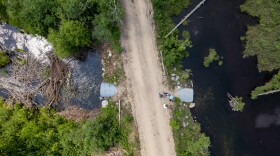-
Northern Michigan University criminal justice students are learning how to investigate and prevent poaching.
-
For the last 30 years, the Cadillac Area Land Conservancy has worked to protect and preserve land across the state of Michigan. The conservancy partners with landowners to preserve their land for future generations. The nonprofit provides landowners with the resources they need to identify the value of their land and protect it.
-
After the great “moose lifts” in the 1980s, researchers were confident Michigan’s moose population would continue to grow, with a projection that the population could reach numbers in the thousands within 15 years. Researchers from DNR, the Keweenaw Bay Indian Community and Northern Michigan University are trying to discover why that hasn’t happened.
-
The money was slotted for stream restoration and farmland preservation across the region.
-
Soil and Water Conservation Districts have worked with farmers for decades in every U.S. state to reduce soil erosion and promote conservation. After two years of funding cuts in Illinois, conservation advocates worry that soil health could suffer – and dust storms could become a greater risk.
-
One has funding delayed on nearly half its projects.
-
This is the first “organization-led” land purchase in the conservancy’s more than 30-year history.
-
Two union leaders in Michigan confirmed with WCMU that at least 15 people from Huron-Manistee, 14 from Hiawatha and eight from the Ottawa national forests were affected by the layoffs.
-
Ice shanties dot the horizon as the sun rises over the frozen Black Lake. It’s only 4'F out, but hundreds of people have gathered here — all because of the elusive, prehistoric lake sturgeon.
-
A northern Michigan homeowner was surprised to see a hummingbird at his feeder in the middle of winter. But the intrigue only increased when the little bird turned out to be a species that's native to the West Coast.
Play Live Radio
Next Up:
0:00
0:00
Available On Air Stations





![Dust storm approaching Bloomington, Illinois. [Photo courtesy of Chicago NWS and Jason Borchardt.]](https://npr.brightspotcdn.com/dims4/default/c2bc811/2147483647/strip/true/crop/1011x563+0+135/resize/280x156!/quality/90/?url=http%3A%2F%2Fnpr-brightspot.s3.amazonaws.com%2F68%2Fe6%2F5c0231a84edabc4144f1191a4d45%2Fjasonborchardt-bloomington1-jpg.jpeg)



